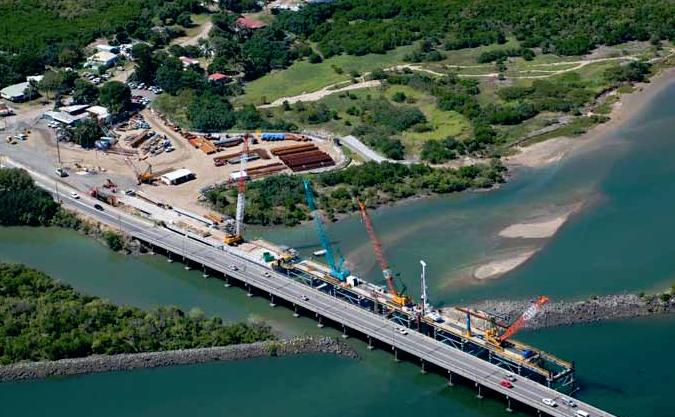
Project manager Richard Malowiecki tells Gary Toushek of the many challenges Golding Contractors has had to overcome to build a replacement bridge in an environmentally sensitive area.
Founded in 1942 by Cyril Golding in Gladstone, Queensland, Australia, Golding Contractors began as a one-man operation in the logging industry during World War II with a truck and a bulldozer. He toiled many hours constructing dams and minor earthworks to build up his company and add workers. Eventually, part of his crew worked on mining sites, while the other part constructed bridges and civil projects. The workforce grew to 1,800, operating one of the largest privately owned earthmoving fleets in the southern hemisphere. The company was family owned until being acquired by CHAMP Private Equity in early 2008.
Since May 2008 Golding has been constructing a new bridge in Mackay on the coast of Queensland. Project manager Richard Malowiecki, with 30 years’ experience in civil projects, describes the scope of the $128 million Forgan Bridge Replacement Project. “We’re building a new bridge alongside the current bridge,” he says. “When complete we will switch traffic over to the new bridge, demolish the old bridge and construct another new bridge in its place. There’s also another short, six-lane bridge across Barnes Creek, plus nearly a kilometer of roadwork running along Barnes Creek Road, as well as two signalized intersections at each end of the project.”
This is actually the third bridge on the same site; the original one built in the 1880s was hit by a ship that took out a few spans of the bridge and sank on the spot. The rest of the bridge was badly damaged by a cyclone in 1918. The second, current one was built in 1937–38 and has reached the end of its economic life, with ongoing maintenance being impractical. Because it’s adjacent to the center of the city, planning the construction around traffic is a challenge, says Malowiecki.
“Since we have to leave the current two lanes operational while we construct the new lanes, we’re working in and around traffic, which makes the construction very linear and relatively lengthy. At the moment, all our office space, warehouse and storage facilities are on ‘the works’ side of the road, but for stage two of the job, when we move to the other side of the road, we’ll have to cross the two new lanes now under construction to get access to the old bridge side. So there are challenges with the geometric layout of the job.”
The crew has built a falsework deck, and services (such as power lines, sewage pipes, etc.) have to be relocated from the old bridge to the new one. “And since we’re not in the same footprint,” Malowiecki says, “those services have to be fully installed on the new bridge before we can decommission the services on the old bridge, which requires detailed service staging on both sides of the road. Some of the timing is beyond our control, as the service authorities have to do the final connections. The staging of the job is complicated, compounded by switching the traffic over.”
A lot of the roadwork is built over marine mud in various areas, so stabilization piles are used, as well as pre-loaded earthworks. A lot of the project is dependent on how those settlement earthworks go. “We have to monitor the settlement to determine the timing of follow-on works.”
Another complication, he notes, is that the area is known for its relatively complex geotechnical material, which has been detected during the construction of other bridges built over the Pioneer River in Mackay. “The ground has very hard rock material interspersed with weaker layers and vertical dykes,” says Malowiecki. “So we have piles immediately adjacent to each other pulling up at considerable distances apart. We also knew that it would be a complex geotechnical job, so the piling is really difficult.”
There’s also an existing sewer line running alongside the old bridge, which converts to asbestos pipe in fairly poor condition when it leaves the bridge on both ends, and the crew has had to drive piles very close to it, needing to take great care. “We’re using vibration monitors; we’ve had to stabilize the pipe because if damaged, there is no easy way to limit the flow between our project and the treatment plant,” says Malowiecki.
This bridge is in an environmentally sensitive area, mainly because the river flows out to the Great Barrier Reef. Therefore, there are many restrictions on what can be done in the river. The crew performs continuous monitoring of the water quality and has designed its construction processes to avoid any unintended deposits into the river. Interestingly, they’ve come across pieces of that earlier shipwreck while working and have stopped work while archeologists were called in to examine the findings.
Included on the downstream side of the new bridge will be a five-meter-wide walkway shared by pedestrians and cyclists, which at the city center side will connect to Mackay City Council’s riverside promenade. The work is mostly self-performed, with very little subcontracting. Traffic will be switched over from the old bridge to the new one by early next year, when work will begin on stage two. The project is slated for completion in early 2011.













